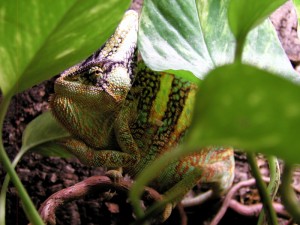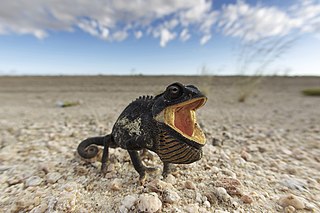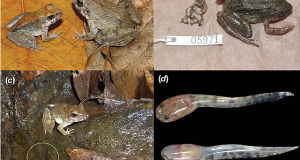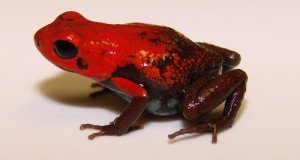My grandfather cautioned me never to bet on a boxing match, as they were even less predictable than horse races. But where chameleon fights are concerned, it seems that picking a winner is a simple matter. A recent study revealed that color intensity and the speed with which a male can elicit color changes accurately predicted the winner of an aggressive encounter. Furthermore, different areas of the body are used to covey specific types of information. Chameleons know this, of course…which is why most contests end without physical contact between competing males.
Camouflage, Display, or Both?
Years ago, chameleons were thought to change color primarily to camouflage themselves from predators and prey. In time, we learned that temperature, health, stress levels, dominance and other factors also played a role.
In recent years, researchers at Melbourne University discovered that communication, not camouflage, was the driving force behind the evolution of chameleons’ amazing abilities. However, their work revealed that camouflage is involved as well. At least one species, Smith’s Dwarf Chameleon, Bradypodium taeniabronchum, changes color when a predator appears…and the degree of color change varies according to the type of predator it faces! You can read more about both studies in the articles linked below.
Colors Convey Distinct Message
s
Veiled Chameleons, Chamaeleo calyptratus (which are unsociable even by chameleon standards!) were the subject of a recent study that examined color change and aggression (Biology Letters, 2013; 9 (6)). Researchers at Arizona State University photographed and analyzed 28 distinct areas on the bodies of male chameleons involved in aggressive displays with rivals. The brightness of the colors exhibited in certain body stripes foretold which of the chameleons would make the initial approach towards the other. Head color intensity accurately predicted the contest’s winner. The speed with which the various color changes took place also affected the fight’s outcome.
The vast majority of the staged aggressive encounters ended without physical combat. The rare battles that did occur lasted a mere 5-15 seconds.
Why Quit Before the Fight Begins?
I’ve read elsewhere that color change takes a heavy toll, metabolically, on a chameleon. I imagine that a male who can quickly summon up a variety of bright, intense colors is viewed by rivals as being healthy and vigorous, and therefore not worth tackling. Similar considerations may influence mate choice as well.
Seeing as a Chameleon Sees
Chameleons and many other creatures do not perceive colors as we do. The Arizona State University study was the first to examine the effects of color change “through the eyes” of an animal. Using a process that I did not completely (or, truthfully, even barely!) understand, specialized cameras and information concerning chameleon visual sensitivity allowed researchers to measure colors as they are actually seen by chameleons.
Further Reading
Chameleon Color Change: Advertising and Camouflage
Chameleon Basking Influenced by Vitamin D Levels in Blood
 That Reptile Blog – Reptile, Amphibian and Exotic Pet Care and Information
That Reptile Blog – Reptile, Amphibian and Exotic Pet Care and Information







Thank you for the interesting article. Did the Arizona State University study mention how the chameleons’ visual sensitivity is different from that of people and of other animals?
Hello Eva,
Thanks, glad you enjoyed.
There seems to be great variations among chameleon species, as to how they perceive color, brightness, etc., and as o how this differs from other species. Most studies seem to look at vision as a side issue; I’ve not seen much directly on point; this article is an example. Mantis shrimp have been the real surprise in this area…you may enjoy this article. Best, Frank